Imagine soaring to new heights, feeling the rush of adrenaline as your very own model rocket pierces the sky. Welcome to the world of beginner model rockets, where creativity meets adventure and the thrill of exploration awaits. Whether you're a curious newcomer or a seasoned enthusiast, this comprehensive guide will propel you into the exciting realm of model rocketry, covering everything from the basics to expert tips and tricks.
Quick Links to Useful Sections
- What Are Model Rockets?
- The Basics of Model Rocketry
- Choosing the Right Model Rocket Kit
- Building and Preparing Your Model Rocket
- Launching and Recovering Your Model Rocket
- Tips and Tricks for Beginner Model Rocketeers
- Resources and Community Support: Your Next Steps
- Frequently Asked Questions: Beginner Model Rocketry
What Are Model Rockets?
Model rockets are scaled-down versions of real rockets, designed to be launched and recovered safely. They typically range from simple, entry-level kits to complex, high-performance models, offering a wide spectrum of possibilities for enthusiasts of all ages.
With model rockets, you can experience the excitement of space exploration without breaking the bank or requiring extensive technical expertise. From backyard launches to competitive events, model rocketry is an engaging hobby that fosters creativity, problem-solving, and critical thinking.
The Basics of Model Rocketry
Before you start building and launching, it's essential to understand the fundamental components of a model rocket:
- Nose Cone: The pointed tip of the rocket, which helps reduce air resistance during ascent.
- Body Tube: The main structure of the rocket, housing the payload, recovery system, and electronics.
- Fins: Stabilizers that ensure the rocket flies straight and maintain control during descent.
- Motor: The propulsion system, typically a solid-fuel rocket motor, which generates thrust.
- Recovery System: A parachute or streamer that deploys to slow the rocket's descent and ensure a safe landing.
Familiarize yourself with these basic components, and you'll be well on your way to building and launching your first model rocket.
Looking For The Best Model Rocket Kits? You'll Love These:
Choosing the Right Model Rocket Kit
With so many model rocket kits available, selecting the perfect one can be overwhelming. Consider the following factors to find the ideal kit for your needs:
- Skill Level: Beginner, intermediate, or advanced kits cater to different levels of experience and expertise.
- Scale: Kits come in various scales, from mini to large, affecting the rocket's size and complexity.
- Motor Type: Choose between A, B, C, or D motors, each with its own power and altitude capabilities.
- Features: Some kits include additional features like payload bays, cameras, or electronic systems.
Research and compare different kits to find the one that aligns with your interests, skill level, and budget.
Building and Preparing Your Model Rocket
Once you have your kit, it's time to start building and preparing your model rocket for launch:
- Follow Instructions: Carefully read and follow the kit's instructions to ensure a successful build.
- Use Quality Materials: Invest in good-quality adhesives, paints, and other materials to ensure a durable and long-lasting rocket.
- Conduct Safety Checks: Inspect your rocket for any defects or damage before launching.
- Prepare the Launch Site: Choose a safe, open area with minimal wind and obstacles.
Attention to detail and patience are key when building and preparing your model rocket.
Launching and Recovering Your Model Rocket
The moment of truth has arrived – it's time to launch your model rocket:
- Check Weather Conditions: Avoid launching in strong winds, rain, or extreme temperatures.
- Assemble the Launch Pad: Set up the launch pad according to the manufacturer's instructions.
- Countdown and Launch: Follow the countdown sequence and launch your rocket.
- Track and Recover: Use a tracking device or visual observation to locate and recover your rocket after launch.
The thrill of launch and recovery is what makes model rocketry so exhilarating – be prepared for an unforgettable experience!
Tips and Tricks for Beginner Model Rocketeers
As you embark on your model rocketry journey, keep these expert tips in mind:
- Start Small: Begin with simple, low-power kits and gradually move to more complex models.
- Practice Safety: Always follow safety guidelines and precautions when launching and handling model rockets.
- Join a community: Connect with local model rocket clubs or online forums to learn from experienced enthusiasts.
- Experiment and Innovate: Don't be afraid to try new designs, materials, or techniques to improve your model rockets.
By following these tips and staying committed to your craft, you'll quickly become a skilled model rocketeer.
Resources and Community Support: Your Next Steps
As you continue to explore the world of model rocketry, take advantage of these valuable resources and community support:
- Model Rocketry Clubs: Join local clubs or online forums to connect with fellow enthusiasts and learn from their experiences.
- Tutorials and Guides: Utilize online tutorials, videos, and guides to improve your building and launching skills.
- Model Rocket Manufacturers: Visit the websites of reputable manufacturers, such as Estes or Apogee, for kits, accessories, and expert advice.
- Competitions and Events: Participate in local or national competitions to showcase your skills and learn from others.
Stay connected with the model rocketry community, and you'll find endless opportunities for growth, learning, and excitement.
Frequently Asked Questions: Beginner Model Rocketry
Here are some frequently asked questions about beginner model rocketry:
1. What is the best model rocket kit for beginners?
Look for kits labeled as "beginner-friendly" or "easy to assemble." Estes and Apogee offer excellent starter kits.
2. How high can model rockets fly?
Altitudes vary depending on the motor and design, but beginner rockets typically reach 100-500 feet.
3. Are model rockets safe?
Yes, when built and launched according to safety guidelines and precautions.
4. Can I build my own model rocket from scratch?
Yes, but it's recommended to start with a kit and gain experience before attempting a custom build.
5. How much does it cost to get started with model rocketry?
Beginner kits can start as low as $20, while more advanced models can cost upwards of $100.
Looking For The Best Model Rocket Kits? You'll Love These:
Useful Interruption: Dive deeper into the world of Model Rockets with our most popular sections. If there is anything you think is missing or anything you would love for us to write about, just give us a shout.
- Getting Started & Basics With Model Rockets
- Model Rocket Design, Build & Customization
- Model Rocket Propulsion & Engine Technology
- Model Rocket Launch Techniques & Recovery
- Model Rocket Advanced Rocketry & Innovations
- Model Rocket DIY and Customization
- Model Rocket Equipment Reviews & Digital Tools
- Community, Competitions & Education
- Model Rocket Troubleshooting & FAQs
- Model Rocket Bonus/Seasonal & Niche Topics
A group of model rocket enthusiasts gathered at a field for their weekly launch event. Among them was Dave, a seasoned builder known for pushing the limits of hobby rocketry. This time, he had outdone himself.
“Ladies and gentlemen,” Dave announced, dramatically pulling a cloth off his latest creation, “I present to you: The Kraken!”
The crowd gasped. This wasn’t just a model rocket, it was a monster. The thing stood 8 feet tall, had six clustered engines, and was covered in enough duct tape to qualify as a classified aerospace project.
“Dave,” muttered Steve, the cautious safety officer, “Have you, uh… done the math on this?”
“Math?” Dave scoffed. “I built it in my garage at 3 a.m. with parts from eBay. This is an art piece, Steve.”
The countdown began.
5…
4…
3…
2…
1…
The engines ignited with a BOOM, and The Kraken shot up… kind of. It immediately did a violent barrel roll, narrowly missing the spectators before skyrocketing at an angle that could only be described as “legally questionable.”
The crowd collectively ducked as The Kraken flew straight over the adjacent cornfield, where Old Man Jenkins, the grumpiest farmer in town, was minding his business.
KABOOM!
The rocket disappeared behind the barn. A moment later, a flaming piece of Estes igniter wire landed at Steve’s feet. The silence was deafening.
And then, an unmistakable sound echoed across the field.
Jenkins’ shotgun being cocked.
“DAVE!!!” Steve shouted. “RUN.”
And that was the day Dave invented the first-ever biologically powered rocket booster: pure adrenaline.
To this day, nobody knows where The Kraken landed, but legend has it, it still haunts the skies, terrifying unsuspecting drones and low-flying birds.















